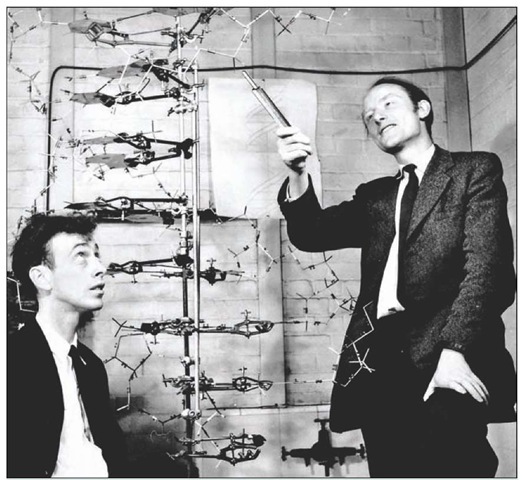Here is my answer on many levels.
Lets start with this early x-ray picture of the DNA molecule next to Rosalind Franklin who succeeded in producing it:
The steps leading to this image were first and foremost the basic curiosity: We want to know! Then those curious people start looking and finding things out step by step.
Discoveries in science are always based on previous knowledge. Most of the time it takes a team of people cooperating with their shared curiosity and intelligence to figure out the most astounding facts of nature. In the case of DNA there were the previous methods to isolate the genetic material from Bacteria. It was known how to label it with radioactive material. The newest technology was x-ray crystallography. Rosalind Franklin was a bright researcher trained in this technique. She produced these now famous images and was just about to decipher them. After working for years with the unsafe radiation she developed ovarian cancer and died before she could get any recognition.
An additional level in all this is the personalities of these bright researchers. Often we find that the most studious hard working researcher is looked over and someone new with a strong ego takes over and takes all the credit. James Watson an American molecular
biologist and Francis Crick the Physicist from UK were working on this project at the same time. They got hold of Rosalind Franklin's x-ray images and worked together to discover the detailed structure of the DNA double helix:

This was not a simple task. It involved the knowledge that this genetic material includes the four nucleic bases. These four basic structures are found in the nucleus of the bacteria cell, and that is why they are named nucleic bases. The initials are A, G, C, T.
You will find these letters in DNA sequences.
They also knew that the DNA material includes the sugar ribose with one less oxygen (deoxyribose) and phosphate.
They had to build the model of these bases and figure out the structure so that it will fit the x-ray image. James Watson and Francis Crick were the firsts to publish this result and win the Nobel Prize. The Nobel Prize in Physiology or Medicine 1962 was awarded jointly to Francis Harry Compton Crick, James Dewey Watson and Maurice Hugh Frederick Wilkins "for their discoveries concerning the molecular structure of nucleic acids and its significance for information transfer in living material".
The most amazing part of this research is that this structure predicts that every 3 nucleic bases will be a code for one amino acid. This is how the genetic material in the cell nucleus is translated to proteins in the cell. The proteins that are part of the structure of the cell and have many metabolic activities.
This discovery has connected chemistry and biology!
Fifty years later Francis Crick predicted that the next breakthrough in science will be the connection between bilogy and behavior!
An additional level in all this is the personalities of these bright researchers. Often we find that the most studious hard working researcher is looked over and someone new with a strong ego takes over and takes all the credit. James Watson an American molecular
biologist and Francis Crick the Physicist from UK were working on this project at the same time. They got hold of Rosalind Franklin's x-ray images and worked together to discover the detailed structure of the DNA double helix:

This was not a simple task. It involved the knowledge that this genetic material includes the four nucleic bases. These four basic structures are found in the nucleus of the bacteria cell, and that is why they are named nucleic bases. The initials are A, G, C, T.
You will find these letters in DNA sequences.
They also knew that the DNA material includes the sugar ribose with one less oxygen (deoxyribose) and phosphate.
They had to build the model of these bases and figure out the structure so that it will fit the x-ray image. James Watson and Francis Crick were the firsts to publish this result and win the Nobel Prize. The Nobel Prize in Physiology or Medicine 1962 was awarded jointly to Francis Harry Compton Crick, James Dewey Watson and Maurice Hugh Frederick Wilkins "for their discoveries concerning the molecular structure of nucleic acids and its significance for information transfer in living material".
The most amazing part of this research is that this structure predicts that every 3 nucleic bases will be a code for one amino acid. This is how the genetic material in the cell nucleus is translated to proteins in the cell. The proteins that are part of the structure of the cell and have many metabolic activities.
This discovery has connected chemistry and biology!
Fifty years later Francis Crick predicted that the next breakthrough in science will be the connection between bilogy and behavior!
.


No comments:
Post a Comment